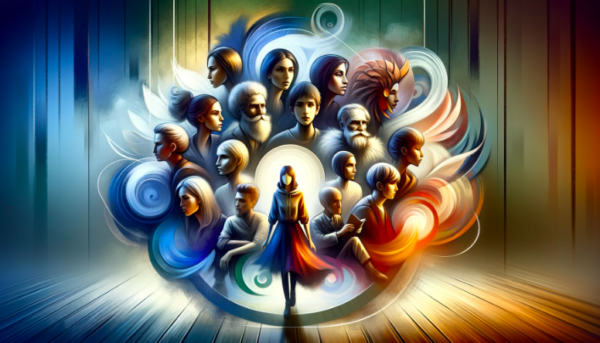Dive into the secret sauce of unforgettable storytelling—character development! It’s not just a buzzword in writer’s workshops or the reason behind your favorite character’s questionable fashion choices. No, character development is the heartbeat of any tale, the reason you cheer, jeer, or shed a tear. It transforms mere sketches on a page into friends you’ve never met and enemies you’re glad you haven’t.
But what is character development? Central to this concept is the character arc—a crucial element that charts a character’s transformation or journey throughout the story. Grasping the nuances of different character arcs is essential for propelling the narrative and making characters vibrant and engaging.
Another vital aspect is the role of secondary characters. Though not the primary focus, these characters are key in enriching the narrative and supporting the main storyline. They must be thoughtfully designed to add depth without overshadowing the protagonists.
Lastly, this article will explore believability —the quality that makes characters resonate with audiences on a realistic and relatable level. Techniques to craft authentic and believable characters will be discussed, aiming to ensure they make a lasting impression on the reader.
This article unpacks key concepts, offering insights and practical tips for crafting characters that are not only memorable but deeply engaging and emotionally resonant, helping you enrich your storytelling journey.
Character Development
In the realm of storytelling, the intricacies of character development transcend mere artistic choice—they are fundamental to narrative success. Halley Nicole Villegas, in her comprehensive study at Liberty University, underscores the pivotal role of character growth in enhancing plot progression and deepening emotional resonance. Through her analysis, Villegas demonstrates how nuanced character arcs not only reflect human experiences but also significantly bolster reader engagement. Her work offers an extensive exploration of these dynamics, providing a solid foundation for writers aiming to craft more relatable and impactful stories.
Character Development Definition
At its core, great character development is about evolution and depth. It involves creating interesting characters who over the course of the story, influenced by events and their interactions with other characters. This development is significant because it not only drives the plot but also enables readers or viewers to see parts of themselves in the characters, forging a deeper connection with the story. Understanding the importance of character development helps us appreciate how these elements contribute to making narratives relatable and impactful.
9 Steps to Developing a Character
Dive deeper into the art of character creation with these detailed steps, each designed to build upon the last, creating a seamless flow from one crucial aspect to another.
Step 1: Background and History Every character has a past that shapes who they are today. Delve into crafting a backstory that informs the character’s current motivations and behaviors, like Harry Potter’s early years, which significantly influenced his compassion and resilience.
Step 2: Personality Traits and Characteristics Explore the intricacies of attributes that define a character’s behavior across different situations. How do traits like Katniss Everdeen’s bravery or Sherlock Holmes’ intelligence make them both memorable and distinct?
Step 3: Motivations and Desires Unravel the layers of what drives your characters. What desires propel them through the narrative? For instance, Jay Gatsby’s relentless pursuit of Daisy Buchanan shapes his actions and ultimately, his destiny.
Step 4: Flaws and Vulnerabilities Consider the flaws that make your characters human and relatable. How do Atticus Finch’s noble ideals both uplift and blind him to the realities around him?
Step 5: Relationships and Interactions How do your characters interact with others in their world? Develop dynamics that reveal deeper aspects of their personality and contribute to their narrative growth.
Step 6: Internal Conflicts and Struggles Focus on the internal battles that define a character’s journey. What moral dilemmas or personal fears do they face, and how do these struggles enrich their development?
Step 7: Evolution and Growth Document the transformation characters undergo as a result of their experiences. How does overcoming challenges or learning from mistakes contribute to their evolution?
Step 8: Cultural and Social Influences How does the cultural and social backdrop influence your characters’ views and behaviors? Integrating these factors can add a layer of realism and depth to their development.
Step 9: Physical Characteristics and Mannerisms Finally, describe your characters’ physical attributes and mannerisms. How do these small details contribute to their overall persona and audience perception?
By considering these steps, you can craft characters that not only resonate with readers but also leave a lasting impact. Think about how these elements can work together in your own writing. What unique mix will bring your characters to life?
Character Development Examples from Popular Literature
These theoretical aspects of character development are brought to life through countless examples in literature and cinema. In the film, well-developed characters like Luke Skywalker from “Star Wars” exemplify the hero’s journey, with his background, traits, motivations, and flaws all contributing to his memorable character arc. Similarly, in literature, Elizabeth Bennet from Jane Austen’s “Pride and Prejudice” stands out for her sharp wit and independent spirit, traits that both aid and complicate her relationships.
By examining these steps and examples, one can see how integral character development is to storytelling. It’s a process that requires thoughtfulness and creativity, but when done right, it creates compelling characters that resonate with audiences long after the story ends.
Character Arc
A character arc is the transformation or journey that a character undergoes throughout a story. It is a critical element of narrative writing that adds depth and realism to characters, making them more engaging and relatable to the audience. This transformation can be emotional, moral, or physical, and it fundamentally alters how the character interacts with the world and other characters in the story.
Types of Character Arcs:
- Positive Arc (Transformation/Growth): Here, a character overcomes internal or external obstacles and grows positively. This type of arc often involves the character achieving a deeper understanding of themselves or the world, leading to personal growth or transformation. For example, in Charles Dickens’s “A Christmas Carol,” Ebenezer Scrooge undergoes a profound transformation from a miserly, lonely man to one filled with generosity and kindness.
- Negative Arc (Downfall/Tragedy): Contrary to the positive arc, the negative arc involves a character’s decline, often due to their own flaws or mistakes. This arc can be tragic and is commonly found in stories with cautionary themes. An example is Anakin Skywalker from “Star Wars,” whose arc from a promising Jedi to the villainous Darth Vader is marked by his surrender to fear and anger.
- Flat Arc (Steadfast Character): In a flat arc, the character remains fundamentally unchanged throughout the story. Instead, their core beliefs and values are tested and ultimately affirmed. This type of arc is common in characters who represent an ideal or truth. Atticus Finch in Harper Lee’s “To Kill a Mockingbird” is an example, as his strong moral compass remains intact despite the challenges he faces.
Importance of the Arc in Driving the Story
The character arc is essential in driving the story forward and maintaining the audience’s interest. It provides a structure for the narrative, giving the audience a reason to invest in the character’s journey. A well-crafted arc not only ensures character development but also contributes to the overall theme and message of the story.
Crafting a Compelling Character Arc:
- Establishing Stakes and Goals: For an arc to be compelling, a character must have something significant at stake and clear goals they are striving to achieve. This creates investment and empathy from the audience.
- Showing Change and Growth: Demonstrating the character’s evolution is key. This involves showing how they react to challenges and conflicts, and how these experiences change them.
- Resolution and Impact on the Story: The arc should have a resolution that is satisfying and impactful. The character’s journey should influence the story’s outcome and leave a lasting impression on the audience.
Case Studies of Effective Character Arcs in Fiction:
Examining successful character arcs in fiction provides valuable insights into their construction. Elizabeth Bennet in “Pride and Prejudice” by Jane Austen undergoes a positive arc, as she overcomes her prejudices and evolves in her understanding of love and relationships. Conversely, Walter White from the television series “Breaking Bad” is an example of a negative arc, as he transforms from a sympathetic character into a morally corrupt one.
Secondary Characters
Secondary characters play a crucial role in enriching the tapestry of storytelling. While they may not occupy the center stage like primary characters, their presence, development, and interactions significantly enhance the depth and realism of the narrative.
Role and Importance of Secondary Characters
Secondary characters serve various functions in a story. They can be catalysts for a primary character’s development, provide necessary plot exposition, offer alternate perspectives, or add layers to the thematic fabric of the narrative. Their interactions with the main characters and the world around them contribute to a richer, more believable story.
Differentiating Secondary from Primary Characters
The key difference between primary and secondary characters lies in their centrality to the plot. Primary characters drive the story forward with their decisions and actions, while secondary characters support this progression. Secondary characters typically have less screen or page time, but this does not diminish their importance. They often provide crucial support or opposition to the main characters, influencing the direction and outcome of the story.
Building Depth in Secondary Characters
In storytelling, secondary characters play more than just supporting roles; they add layers of complexity and richness to the narrative. Building depth in these characters is crucial for a well-rounded and engaging story. This section will explore the techniques and nuances of giving secondary characters the depth they deserve, ensuring they contribute significantly to the story while maintaining their unique identities.
Let’s delve into how secondary characters can be developed with the same care and attention to detail as primary characters, enhancing the overall tapestry of the narrative.
- Giving Them Their Own Goals and Motivations: To create multidimensional secondary characters, they should have their own desires and objectives. These motivations may align with or contradict the main characters’ goals, adding complexity to the narrative. For instance, Hermione Granger in the “Harry Potter” series, while not the protagonist, has her own distinct ambitions and beliefs that influence her actions and interactions.
- Interactions with Main Characters: How secondary characters interact with primary characters can reveal different facets of both. These interactions can highlight contrasts, create conflict, or provide support and aid to the primary characters.
- Contribution to the Plot and Themes: Secondary characters should contribute to the story’s plot and underlying themes. They can embody thematic elements or provide subplots that reinforce the overall message of the narrative.
- Balancing Development Without Overshadowing Main Characters: While secondary characters need to be well-developed, their stories should not overshadow the primary narrative. The key is to strike a balance where they are interesting and well-rounded but still serve to enhance the main character’s journey and the primary plot.
Examples of Memorable Secondary Characters in Literature and Film
In literature and film, there are numerous examples of secondary characters who have left a lasting impact. Samwise Gamgee in J.R.R. Tolkien’s “The Lord of the Rings” series is a quintessential secondary character whose loyalty and courage are pivotal to the story. In film, characters like Han Solo from “Star Wars” offer charm and wit, providing a counterbalance to the more serious protagonists and enriching the narrative.
Believable Characters
Creating believable characters is essential in storytelling, as it allows readers or viewers to connect with and invest in the narrative. Believable characters feel real; they possess qualities that resonate with audiences, transcending the boundary between fiction and reality.
Techniques to Create Realistic Characters
Creating believable and compelling characters is a fundamental aspect of successful storytelling. To achieve this, writers often employ various techniques to infuse authenticity into their fictional creations. Here are some key strategies to help you craft realistic characters:
- Real-World Inspiration: Drawing inspiration from real people adds a layer of authenticity to characters. When writers observe people’s behaviors, speech patterns, and interactions in everyday life, they gain valuable insights that can be used to create realistic characters. These observations help writers infuse their characters with relatable qualities, making them more genuine and relatable to readers or viewers. By mirroring real-world nuances, characters become more dynamic and believable.
- Consistency in Behavior and Speech: Consistency is a cornerstone of character development. It helps in building trust with the audience. A character’s actions and dialogue should remain consistent with their established personality, background, and current situation in the story. When a character’s behavior aligns with their known traits, it reinforces the audience’s understanding of the character and their motivations, leading to a more immersive and believable narrative experience.
- Relatable Flaws and Strengths: Imperfections are essential for creating realistic and relatable characters. No one is without flaws, and even the most heroic or virtuous characters should have vulnerabilities and weaknesses. These flaws humanize characters and make them relatable to readers or viewers. Balancing these flaws with strengths adds depth and realism, reflecting the true complexity of human nature. It also allows for character growth and development as they grapple with their imperfections.
- Avoiding Stereotypes and Clichés: To create believable characters, writers must steer clear of relying on stereotypes and clichés. Overused character types and predictable traits can make characters feel one-dimensional and uninspired. Well-crafted characters should defy simple categorization and challenge conventional archetypes. By breaking away from stereotypes, writers can create unique and memorable characters that surprise and engage the audience, contributing to the originality and authenticity of the story.
- The Role of Research in Crafting Believable Characters: Research is a vital component of crafting believable characters, especially when writing about experiences different from the writer’s own. Thorough research into various backgrounds, cultures, and lifestyles is necessary to lend credibility to characters. This research ensures that characters from diverse backgrounds are portrayed accurately and respectfully, avoiding cultural inaccuracies or stereotypes. It allows writers to authentically capture the nuances of different perspectives, enriching the narrative and enhancing the believability of the characters.
Analyzing Examples of Well-Crafted, Believable Characters
Literature and film abound with examples of believable characters. Atticus Finch in “To Kill a Mockingbird” is a well-crafted character whose moral integrity, empathy, and complexity make him relatable and respected. In modern cinema, characters like Tony Stark from the Marvel Cinematic Universe showcase a blend of charisma, vulnerability, and evolution, making him a multifaceted and believable character.
Breathing Life into Your Characters: The Art of Development
Character development is a nuanced and layered process that is fundamental to storytelling. This development not only makes characters memorable but ensures they resonate with realism and depth, thus profoundly affecting the audience’s emotional investment in the story. Advanced techniques in character development enable writers to create complex, multidimensional characters that are integral to the narrative’s success.
Advanced Techniques in Character Development
Creating truly compelling characters requires moving beyond the basics of character creation. Here are some advanced techniques to consider:
- Using Psychological Theories and Models: Employing psychological principles can profoundly influence our understanding of a character’s motivations and behaviors. For example, Maslow’s hierarchy of needs can define a character’s primary motivations, while Jungian archetypes might establish their fundamental personality traits.
- Layering Characters with Complexity: Characters become more engaging when they exhibit a blend of strengths and weaknesses, desires and fears. Integrating these elements with their past experiences shapes their present actions and decisions, adding layers of complexity.
- Evolution of Characters Over a Series: In series or multi-book sagas, characters must evolve in response to ongoing events. This evolution should be gradual and logical, reflecting the continuous impact of their experiences and choices on their development.
- The Impact of Setting and Era on Character Development: The time and place in which a story is set can significantly influence character development. Historical, social, and cultural contexts should inform characters’ attitudes, beliefs, and behaviors, making them appropriate and believable for their setting.
- Balancing Character Development with Plot Advancement: It’s crucial to balance their growth with the progression of the plot. Effective character development should complement and enhance the narrative, not stall it.
- The Importance of Dialogue in Revealing Character: Dialogue is a powerful tool in character development. It can reveal a character’s personality, background, beliefs, and changes over time, contributing significantly to character depth.
Why is Character Development Important?
Character development is essential because it brings characters to life and makes them relatable to the audience. It allows readers or viewers to see parts of themselves reflected in the characters, fostering a deeper emotional connection with the story. Well-developed characters drive the plot by making their decisions and reactions believable and impactful. They add depth to the narrative, making stories more engaging and meaningful. Ultimately, character development is what makes stories resonate with audiences, leaving lasting impressions that transcend the confines of the page or screen.
Tips and Exercises for Writers to Improve Their Character Development Skills
Creating rich and believable characters is a crucial skill for writers. Well-developed characters can elevate your storytelling and captivate your readers. Here are some tips and exercises to help you improve your character development skills:
Character Interviews
Creating an interview scenario with your characters is akin to sitting down with them for a conversation. This technique allows you, as the writer, to engage directly with your characters, posing questions about their lives, experiences, and motivations. By doing so, you can gain insights that you might not have discovered through traditional character planning. These interviews can reveal unexpected layers of your character’s nature, their hidden desires, fears, and the driving forces behind their actions. It’s a dynamic way to breathe life into your characters and develop a deeper understanding of who they are.
Backstory Writing
Writing detailed backstories for your characters, even if this information won’t be explicitly mentioned in the final story, is a powerful tool for character development. This process involves delving into their past experiences, childhood, significant life events, and personal relationships. Understanding the formative moments in a character’s life helps you uncover what drives them in the present. These backstories provide a solid foundation for their motivations, fears, and aspirations, enriching their portrayal and making their actions and decisions more authentic and relatable.
Character Journals
Keeping a journal from a character’s perspective is a deep dive into their psyche. This exercise allows you to immerse yourself in your character’s thoughts, emotions, and experiences. Writing in their voice and viewpoint can provide profound insights into their inner world, helping you understand their unique perspective on the events of the story. It can also reveal the character’s growth and evolution over time, as their journal entries reflect changes in their attitudes and priorities. Character journals contribute to a more authentic and layered portrayal of your characters.
Role-Reversal Scenarios
Placing characters in situations opposite to their typical environment or role is a powerful technique for exploring different facets of their personality. By challenging your characters and pushing them out of their comfort zones, you can reveal new aspects of their character. For example, a confident and assertive character might become vulnerable and introspective when confronted with unfamiliar challenges. Role-reversal scenarios offer opportunities for character growth and transformation, making their development more dynamic and engaging.
People-Watching for Inspiration
Observing real people and their interactions in everyday life can provide a wealth of inspiration for character development. Paying attention to how individuals express themselves through body language, speech patterns, and reactions can help you create believable and nuanced characters. You can draw from these observations to develop character mannerisms, dialogue styles, and authentic reactions to various situations. This technique enriches your characters with real-world authenticity, making them relatable and engaging to your audience.
Start Your Publishing Journey FOR FREECrafting Life Within Pages: The Art and Impact of Masterful Character Development
In the intricate tapestry of storytelling, character development stands out as a fundamental and transformative element. Through this comprehensive exploration of character development, arcs, secondary characters, believability, and advanced development techniques, we’ve uncovered the layers that contribute to creating memorable and impactful characters.
Characters are the lifeblood of a story. Their journeys, growth, and interactions are what connect readers and viewers to the narrative, driving emotional engagement and investment. Whether it’s the protagonist’s transformative arc, the nuanced presence of secondary characters, the authenticity of believable characters, or the complexity achieved through advanced development techniques, each aspect plays a vital role in bringing a story to life.
Writers, both aspiring and experienced, can draw from these insights and techniques to enhance their storytelling craft. By understanding the importance of character development and employing the strategies discussed – from leveraging psychological models to ensuring characters evolve realistically within their settings – storytellers can create worlds populated with characters that resonate with authenticity and depth.
The art of character development is a continual journey of learning and creativity. As writers harness these tools and techniques, they not only hone their craft but also deepen their understanding of the human experience. In doing so, they create not just stories but mirrors reflecting the complexities, struggles, and triumphs of life – forging a connection with audiences that endures long after the final page is turned or the closing credits roll.
Ultimately, the power of well-crafted characters in storytelling cannot be overstated. They are the vehicles through which stories are told and remembered, making the mastery of character development an essential skill for any storyteller committed to creating lasting and meaningful narratives.
FAQs – Character Development Questions
Q1: What are the 4 types of character development?
The four main types of character development are:
- Dynamic Character – A character who undergoes significant internal change throughout the story.
- Static Character – A character who remains largely the same, without major internal growth or transformation.
- Round Character – A well-developed character with depth, complexity, and realistic traits.
- Flat Character – A simple, one-dimensional character with minimal development or change.
Q2: What defines a well-developed character?
A well-developed character has a distinct personality, motivations, and backstory. They have clear strengths and flaws that make them realistic. Their growth or change is influenced by the story’s events (for dynamic characters). They have relatable emotions and decision-making that align with their traits.
Q3: Why is character development important?
Character development is crucial because it creates emotional connections between readers and characters. Character development enhances storytelling by making characters feel real and relatable. It drives the plot by influencing actions and decisions, and adds depth, making stories more engaging and meaningful.
Q4: How do you develop a strong character arc?
To develop a strong character arc:
- Give them a goal or desire – What do they want, and why?
- Establish their flaws and weaknesses – What holds them back?
- Introduce challenges and conflicts – What forces them to change or grow?
- Show gradual development – Let their transformation happen naturally over time.
- Resolve their journey meaningfully – By the end, they should either achieve their goal, learn a lesson, or face the consequences of their choices.
Q5: What is character development?
Character development refers to the process of creating and evolving a character’s personality, motivations, and growth throughout a story. It includes how they respond to challenges, interact with others, and change over time.
Q6: What are the 3 stages of character development?
The three common stages of character development are:
- Introduction & Establishment – The character’s traits, background, and motivations are introduced.
- Conflict & Growth – The character faces challenges that test and shape them.
Resolution & Transformation – The character either evolves or reaffirms their core traits based on their experiences.







